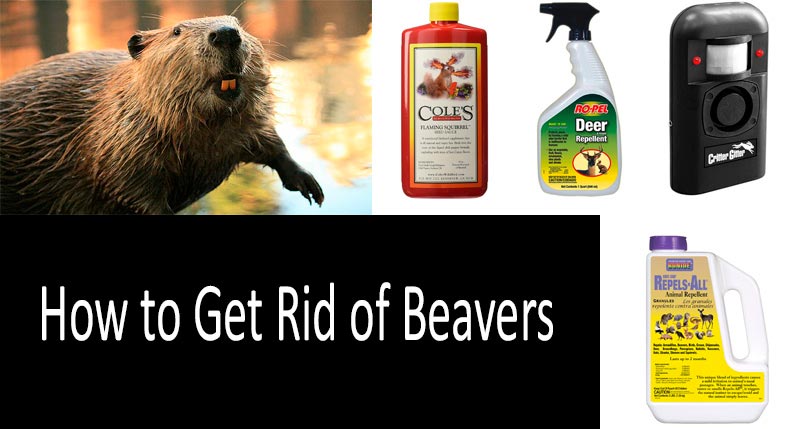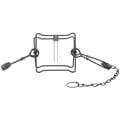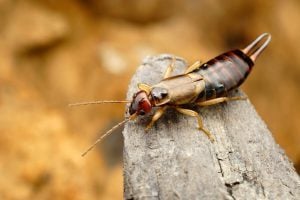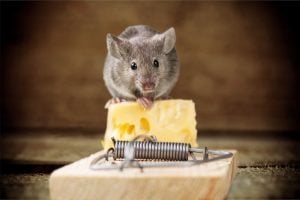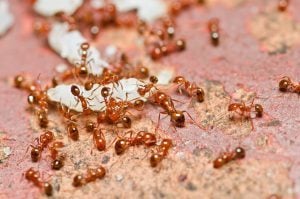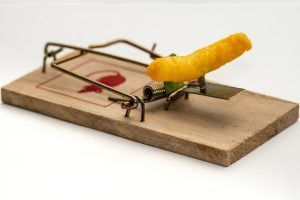This article was reviewed April 2022, and due to Amazon’s new policies for trap sales some of the trap links are unavailable. However, we are working on making these items available to you from a different vendor. Until then, we hope you still enjoy this article and all the information it has to offer. Thank you.
Being the largest and widespread rodent in the USA, the beaver inflicts a considerable damage to human property and infrastructure. What distinguishes beavers from other animals is their hardworking nature. They create their own habitat or change the existing one, instead of using what is available. Observing the beaver behavior, one may imagine that they are inspired by the same ideas as Winston Churchill had, who once said: “It’s not enough to use the situation, one should be able to create it.” Well, these rodents seem to be as resourceful and smart as that great British politician was.
Beavers are building dams of whatever they can find including sticks, rocks and even mud. By doing so, these huge rodents construct ponds and nesting dens which serve as protection against predators. But what is creation for beavers, is the destruction for humans. The name beaver is also connected with valuable fur, which is why these animals are a target for hunters. Their legal status depends on the region of the USA, with some states considering beavers as nuisance animals, while in others states they are primarily furbearers and, therefore, determine the beaver harvest season and how to trap beaver.
This article covers the issue of how to get rid of beavers in accordance with scientists’ recommendations. In particular, what beaver traps should be used, how to keep beaver away be means of beaver repellents and deterrents. For your convenience, we have prepared a comparison table of the suggested methods and a review of TOP products.
How To Identify Beavers?
Like many other rodents, beavers are nocturnal, which is why you would most likely come across traces of their activity rather than the critters themselves. And yet, these animals are conspicuous enough and you can distinguish them easily from others. Large beavers may weigh fifty pounds or more, however, the largest one was recorded weighing as much as 100 pounds. They are approximately 40 inches long and have a characteristic broad paddle-shaped tail. When a beaver slaps the tail against the water, it is sending an alert signal to the colony.
Since beavers have to cut trees and strip off the bark, they have strong teeth. Actually, what makes them capable to do such a tough job are their four large front teeth. The males and females have similar appearances, with their breeding season starting in winter. In spring, females give birth to their young. Beaver live more than ten years in the wild.
What Kind Of Damage Do Beavers Cause?
These natural engineers create ponds not only for themselves, their efforts result in an increase of living species like waterfowl and fish as well as aquatic plants. Sometimes, it can be considered as damage since numerous unwanted animals, birds, and insects are attracted to the site leading to the rise in the number of pests. However, beavers do the useful work as well, particularly by providing extra water sources for livestock, which is especially valuable during droughts. The dens, built of sticks and mud, primarily serve as their food storage and shelter.
Beavers cause several types of damage to private and public property, so let’s have a look at each one separately. First, as a consequence of beavers’ building activity, dams, houses, roads, pastures, and crops can be flooded. According to a study cited by scientists from the University of Nebraska-Lincoln, this type of damage causes annual losses amounting to over $20 million to the timber industry in the South and East of the United States. In case of prolonged flooding, the affected trees will die as well. Public safety is also put at risk because the soil becomes saturated with water beneath roads and bridges threatening their integrity. Most roads cannot withstand the force of water, frequently resulting in the collapse of these infrastructure facilities.
Felling trees is another type of damage caused by beavers. With the help of their large and sharp incisors, they fell small trees which typically do not exceed six inches in diameter. But in some cases, these rodents are able to cut trees which are about 3 feet in diameter. Apart from that, they can strip off the bark of a tree or, to put it otherwise, girdle the trees. The harmed tree often dies in a while because it is the bark that ensures moisture movement from roots to leaves. Beavers can also cause damage by feeding on crops and vegetation. Their diet includes the bark and leaves of various trees, such as maple and birch, while in the warmer months of the years, they consume corn, wheat, soybeans, fruits, and clover. In addition, these rodents can carry diseases, but the danger to humans is ingesting fecal contaminated water. The matter concerns a so-called beaver fever {Giardia} a parasitic infection of the gut, which can be spread through feces in water contaminated by these and other critters. When in doubt, don’t drink the water. They also have a habit of storing food in the den to consume it in winter. Such caches normally include tree branches of up to five inches in diameter.
Note that when seeking food or building material, beavers rarely travel more than 100 yards away from their pond. For this reason, they often exhaust the food supply in the vicinity of the water reservoir and have to move to another site in search of bark and vegetation, abandoning the pond. In the course of time, such abandoned ponds turn into meadows which become home to all sorts of critters.
How To Get Rid Of Beavers
As indicated in a factsheet of the United States Department of Agriculture, the first step to beaver control is exclusion. To avoid beaver damage, wrap ornamental trees and shrubs with hardware cloth or screen with the height of at least 3 feet. Mesh should be at least one inch in size. However, this should be done before beavers will settle in the area. Take into consideration that beavers do not give up easily and may break the barriers, therefore, be sure to install them securely, with the ends wired together. But if you need to protect a large tree belt area, this measure will not help and is evidently impractical. In this case, use electric wires shackled 12 inches above the ground along the shoreline. This will obstruct beavers’ movement into the protected area. It will be helpful to build concrete spillways in the sites where beaver burrow or are expected to.
Nevertheless, Greg K. Yarrow, a wildlife specialist with the Clemson University, points out that excluding beavers from ponds and lakes is hardly realizable and not cost-efficient. He notes that it is possible to prevent damage inflicted to drain pipes and similar structures by means of fencing. And yet, erecting fences is rather a disadvantage than advantage since beavers may also use parts of the fence as building material for their dens. Then, you will first supply these amateur engineers with valuable stuff and, secondly, lure them into the area. Electric fences are helpful either for enclosing a group of trees from these critters or as a horizontal barrier preventing beavers getting from the shoreline to the land.
Cleaning up food and construction materials is a good long-term solution as beavers will figure out that the site is not favorable for them and will move to other location. This is especially effective in areas with cottonwood and willow trees which grow fast and are preferred by beavers. But bear in mind that this measure has an adverse effect on the local ecosystem, in particular, resulting in an increase of water temperatures. Scientists from the University of New Hampshire Cooperative Extension suggest using so-called “beaver pipes”:
“Flooding which has been caused by beavers has been successfully controlled in New Hampshire by the use of “beaver pipes” which are constructed with boards on three sides and coarse wire on the bottom. The pipe is then inserted in the dam to control the water level. The height of the outlet and the length of the pipe are both factors in producing the desired water level,” the researchers say.
Such pipes are recommended for ponds not exceeding ten square miles and should be 12 inches square and 24 feet long. Use a one-inch pine stock as a construction material for the pipe. Place them through the dam, in the place where upstream water is the deepest.
Another method is removing beaver dams but before doing that you should first get rid of beavers themselves. Otherwise, your efforts will be in vain. Also, this is hazardous as you risk drowning. Actually, you should better hire professionals to do that. But if you have made up your mind to conquer it on your own, use a rake to breach the dam and do it gradually, over the course of several days. Explosives and heavy equipment will also do the job. Be sure to check your state’s wildlife regulations as in some regions of the USA these techniques may be banned or limited. Researchers suggest dam removing as a supplementary measure only and claim that this step will not reduce beaver populations. The thing is that demolishing these structures will not force beavers to leave the site. Experience has shown that a totally ruined dam can be easily restored within a day even by a small colony.
Beaver Trapping: Key Facts You Should Know
Trapping regulations vary depending on the state. For example, when pondering how to trap beavers in Wisconsin, you should obtain a trapping license but, before that, complete a course of a special trapper training program. According to researchers from the Wisconsin University, the length of a beaver trapping season depends on the amount of population: the more beavers inhabit the area, the more of them are permitted to trap. Typically, it lasts from October to April. When beavers are a nuisance problem or inflict damage on the territory of the private property, landowners have the right to trap these animals. Note that you cannot trap beavers within 100 yards of any house if the owner has not permitted to do so. And it is only owner who can set beaver traps on their dams located within the property.
Researchers from the Clemson University say that in most situations, beaver trapping is the most effective and environmentally safe way to get rid of beavers. They claim that when knowing beavers’ habits and food preferences, one may catch all the colony over the course of about seven days. To this end, you will need to have at least ten traps which should be set at the nighttime only, when these critters are active. Sure, the presence of several colonies in one site will complicate matters. Beaver trapping is particularly effective in places where these animals have not faced this kind of danger yet and, therefore, have not learned to avoid traps. One of the downsides of this method is the fact that beavers avoid congregating and, at the same time, are very cautious.
Beaver Traps That Are Recommended For Use
Types of traps and trapping techniques differ but not all of them are permitted in each US state. There is a number of trap types, so let’s have a look at the most popular ones.
- A foothold trap consists of two metal jaws. As soon as an animal steps on the triggering device, the jaws are closed by a spring. For beavers, size No. 3 or larger is recommended by specialists from the University of Nebraska-Lincoln. Foothold traps should be set where beavers are most active — remember, they are prone to using the same route when searching for food and building materials. When placing the device underwater, anchor it more than 4 feet deep so that the trapped beaver will die by drowning.
- Snares catch an animal in a different way — around its body. This type of trap is made of a cable formed into a loop which has a locking device. Set snares in beaver runways or entrances into their dens. It will be helpful to use beaver baits to lure the critters into the trap.
- A clamshell trap does not kill the captured animal but requires a beaver bait. The best one is a castor scent of another beaver, the product which is commercially available. Clamshell traps are on the market under different brands such as Hancock and Bailey which are considered to be very effective but too expensive for many homeowners — several hundred dollars. Another drawback is their heavy metal frames making it uncomfortable for you to carry the device over long distances.
- If you prefer cage traps, use those designed for raccoons which are at least 10 x 12 x 3 inches in size. The best site to set such traps is where beavers climb on the land.
- As scientists note, the most effective and commonly used trap is that of a Conibear type. It kills beavers instantly and makes it impossible to escape. The Conibear trap is designed to be set underwater or half submerged in water. Typically, one device is enough per site. You may provoke beavers to be more active by tearing a hole in the dam so that the water will move out of a pond.
Choosing Beaver Repellents & Deterrents
According to studies conducted by the National Wildlife Research Center, repellents have a limited effect on beaver management and should be frequently reapplied. Moreover, no chemical beaver repellant has been registered yet. Then, how to repel beavers? Some solutions intended for other animals like deer and rabbits may be helpful. However, take into account that when faced with insufficient food resources, beavers will not mind consuming plants treated with repellents. Under such circumstances, repellents just will not work.
Repellents based on natural ingredients may work when applied to certain species of vegetation. For example, Hot Sauce normally repels beavers from cottonwood, but it is not the case with red cedar. Among chemical repellents, choose such solutions as Ropel designed to discourage rodents from chewing plants and trees. Their bitter taste may reduce the damage but will not eliminate the beaver problem.
Researchers from the University of Wisconsin suggest that any repellents labeled for the use on trees and shrubs may work against beavers as well. What you need is to determine the proper amount of the substance for application. For Ropel, one gallon is enough for one acre of ten trees. Thiram, another recommended repellent, covers the same area when diluted with one hundred gallons of water.
Some frightening devices may also come in handy. As a beaver deterrent try sirens, strobe lights, and propane cannons. Since these critters are very cautious, combine noisemakers and visual deterrent. Bear in mind that beaver deterrents have only a short-term effect: In one trial, a Critter Gitter, a commercial device which emits a high-pitched sound, was combined with strobe lights to repel beaver from rebuilding a breached dam. The device discouraged beavers only a few days but long enough to allow temporary drainage of the pond.
How to Get Rid of Beavers: Comparison Table of 9 Ways
Effectiveness Scale: 1 being the least, 10 being the most effective.
| Method | Advantages | Disadvantages |
| Placing a hardware cloth or screening trees Effectiveness: 8 | safe and environmentally friendly; does not harm beavers; protects trees from other animals as well | Effective only before beavers have settled in the area; beavers may break the barriers; not practical for large areas. |
| Electric wires or electric fence Effectiveness: 10 | Good option for protecting large areas from beavers as well as for enclosing a group of trees. | You should regularly check its power source; expensive for large areas. |
| Fences Effectiveness: 10 | Recommended for preventing damage to drain pipes and similar structures | Beavers may use parts of the fence as building material |
| Reducing availability of food and construction materials Effectiveness: 10 | A long-term solution; stimulates beavers to change the location; particularly recommended for areas with fast-growing shrubs and plants. | Leads to negative implications for the local ecosystem. |
| “Beaver pipes” Effectiveness: 9 | Scientifically proved to successfully control beavers in ponds | Difficult to construct and install; labor-consuming. |
| Removing beaver dams Effectiveness: 8 | Creates an unfavorable environment for beavers. | Useless in case the beavers are not removed from the site; labour-consuming; requires special skills; a totally ruined dam can be easily restored within a day. |
| Beaver trapping Effectiveness: 10 | Considered by scientists to be the most effective method to get rid of beavers; a variety of traps are available, both live and lethal ones; environmentally safe; it is possible to catch the entire colony within a week. | Harms the captured animal; requires knowledge about beavers, trapping regulations vary depending on the state. |
| Beaver repellents Effectiveness: 6 | Repellents based on natural ingredients is a good supplementary measure to reduce damage to trees and shrubs. | No repellent is registered for beavers; is not considered effective against beavers; does not work in areas with insufficient food resources. |
| Frightening devices Effectiveness: 5 | Effective when noise-making and visual beaver deterrents are used in combination. | A short-term solution and beavers become accustomed to frightening devices very quickly. |
Top-7 Products To Keep Beavers Away
Have a look at a review of TOP 7 products that will be helpful in beaver control. Use a galvanized hardware cloth to protect the most valuable trees and plants from beaver gnawing. Two options of traps, a cage and body trap, are the most effective ways to get rid of beavers. Three different repellents based on natural ingredients and available in granules, liquid, as well as a spray form, will be a good supplementary measure in your beaver management.
Bonide 2361 Animal Repellent, 3 Pounds
The product is available in granules and targets a wide variety of rodents including large ones. Although there is no repellent registered for beavers, the product label says that this solution helps keep beavers away as well. Its active ingredients — dried blood, putrescent whole egg solids, and garlic oil — are natural and safe for animals, humans and the vegetation you are going to treat. This is a taste and odor repellent which works by irritating nasal passages and eyes of the animals. Uncommon for many natural repellents, this one has a long-lasting effect, up to two months.
Bonide Repellent rates 3.1 out of 5 stars. Opinions are divided, with some customers claiming that the product does not work against rodents while others are satisfied with the results. “Beavers were cutting down our trees around a farm pond. We used this Bonide product as directed, set up cameras and after about a week, they simply moved. Our other ponds do not have trees around them, or we would have treated all of the pond areas. We have five ponds. This really worked for us,” one of the customers says.
Price: Check the current price
Cole’s FS16 Flaming Squirrel Seed Sauce, 16 oz
Although this product is designed specifically for squirrels, scientists suggest applying Hot Sauce to keep beavers away from cottonwood. The stuff is not only natural and safe, it contains food-grade ingredients so that you can treat the crop without worrying about any adverse effect.
Why is this product recommended? The thing is that it tastes hot to animals but not to wild birds which are beneficial and are needed in the field to kill pests. The active ingredients include food-grade liquid Habanero chili pepper and soybean oil. It is also easy to apply, just pour the liquid into a bottle and spray the plants to discourage critters from consuming them. The liquid formulation is convenient for you, whereas chili dust may blow in your face when you are mixing the solution.
This repellent is more popular with customers than the previous one, with a rating of 3.9 out of 5 stars in over 400 customer reviews. “Awesome stuff! I spray this on my fruit trees to deter the squirrels & rats from eating my fruit. It really does help but you have to reapply every couple of weeks,” a customer notes.
Price: Check the current price
Ropel Ready to Use Deer and Rabbit Repellent, 32 oz
Ropel is another repellent recommended by scientists for beaver control, although the product is intended to be used against deer and rabbits. The best way of using the stuff is to create a barrier around the valuable trees and shrubs. It can be applied to any plant including vegetables, fruits, and flowers. Ammonium soaps of higher fatty acids are present in the solution as active ingredients. We should remind you that ammonia is a substance contained in the urine of coyotes and other predators and, therefore, many animals associate it with danger.
The product is not popular with customers, rating just 1.7 out of 5 stars in reviews. “Worked for a couple of days and the rodents resumed eating the irrigation tubing,” one of the users complains. Well, we have warned you that repellents generally have a short-term effect and should be repeatedly reapplied. Do not perceive them as the only measure to be taken against beavers but rather as a supplementary measure in an integrated approach.
Price: Check the current price
Amtek Critter Gitter
Frightening devices can also be helpful in keeping beavers away. So, let’s have a look at Critter Gitter suggested by scientists as a good option. The product is equipped with an alarm and flashing device. Its horn emits a 120 dB sound lasting for about 5 seconds. To provide you an idea of how things could look, this can be compared with the noise of a chainsaw or thunderclap, put it another way, the generated sound is loud enough to scare the animal out.
Apart from that, the device has two high-intensity lights which are intended to simulate eyes. As we have mentioned before, only a combination of visual and sound deterrents are effective against beavers. Judging from this, we may conclude that the device meets the required criteria. The animal’s movement is detected by means of composite lens within the range of 40 feet, therefore, a beaver will be scared even before it gets close to the desired plant or tree. A clear disadvantage of the product revealed during scientific tests is its short-term effect. Actually, beavers will soon become accustomed to threatening signals generated by the device. The best way to enhance the effectiveness of this beaver deterrent is to change its location regularly and use the device in combination with other measures.
Critter Gitter rates 2.8 out of 5 stars. Customers mostly dislike the product’s price which they consider to be too high, as well as the fact that the device is not waterproof, although it is designed for the outdoor use. Nevertheless, some users claim that the solution helps to deter beavers: “I use this to keep beavers out of the boat house. Most humane (and less messy) option,” one of the customers says.
Price: Check the current price
Humane Live Animal Trap 31″
This cage trap is cheaper and more humane than the previous product. Made of rigid and durable reinforced steel, the cage is 31 x 11 x 12 inches in size which is more than enough to catch a full-grown beaver. Take into consideration that you need to place a beaver bait there to lure the animal inside. The best bet is the scent of other beavers, as well as the odor of construction materials and food used by them. First of all, consider castor which is secreted by beavers to signal their presence. Also, branches of such trees as aspen and cottonwood will do the job.
is trap is less popular than the previous one, rating 3.6 out of 5 stars in reviews. Some customers are discontent with the quality of the purchased traps as in some cases the products arrive with broken parts of the structure. “It works well, but one of the tabs on the level that functions the trap door broke. There was just enough left that he could rebind it to work the lever,” one of the users says.
Price: Check the current price
YARDGARD Galvanized Hardware Cloth
To protect small areas or several ornamental trees, use a hardware cloth. Having a flexible material, it is easy to assemble and can be cut into pieces. At the same time, the galvanized cloth is double zinc-coated, making the material resistant to rust. This particular product is designed for animal control and is 25 feet in length, although there are different options from 5 to 100 feet.
Using a hardware cloth for beaver control has three major downsides. First, erecting barriers does not work in case beavers have already settled in the area. Secondly, they are capable of tearing up even a strong material, therefore, make sure you have secured the ends tightly. Thirdly, barriers are useless for large areas. This galvanized hardware cloth rates 4.3 out of 5 stars. “We used this to line the inside of our raised vegetable garden to keep the jack rabbits and other critters out. Quality product,” a customer notes.
Price: Check the current price
1/2 Dozen Duke 220 Double Spring Body Trap
Beaver trapping is the most effective way to get rid of these critters because using this method you can eliminate the entire colony. Body trap is the most recommended one for beavers. The jaw spread is 7 x 7 inches in size, ensuring a quick capture of the animal. According to the manufacturer, this solution is widely used by public wildlife agencies as the most effective humane traps for beaver population control. The device weighs more than 13 pounds and is 12 x 10.7 x 8.5 inches full-sized.
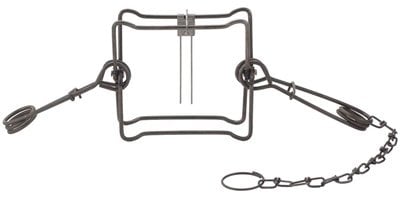
This Double Spring Body Trap is very popular with customers and rates 4.6 out of 5 stars in reviews, with 80% of the users giving the product five stars. Some customers say that these traps are too small for large and full-grown beavers and 330 series are more preferable. “I have caught many a different critter including coons up to 35lbs but the trap only could get around their head. the body would never fit, I set the traps for a head kill because I did not have larger traps,” one customer notes.
Price: Check the current price

